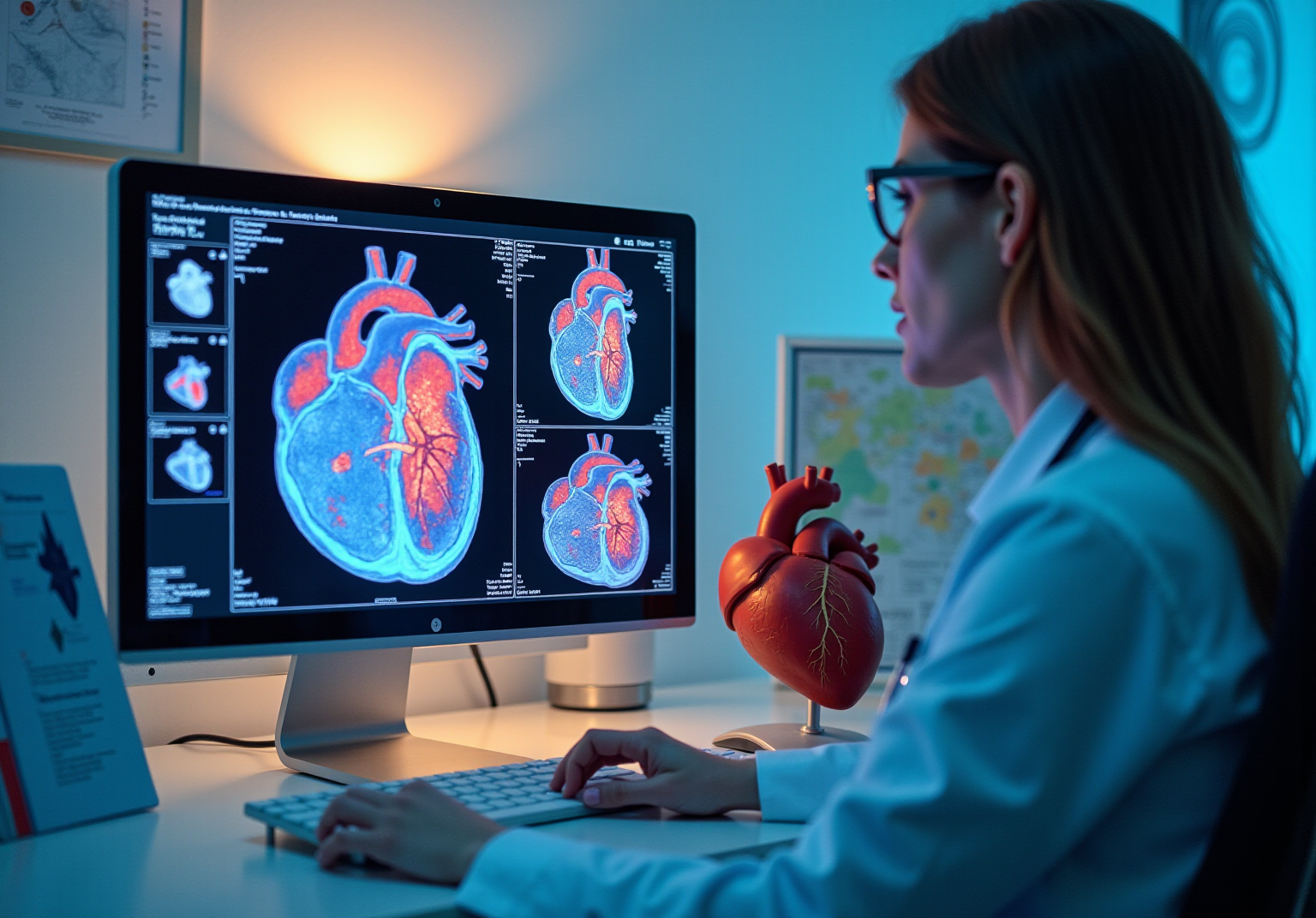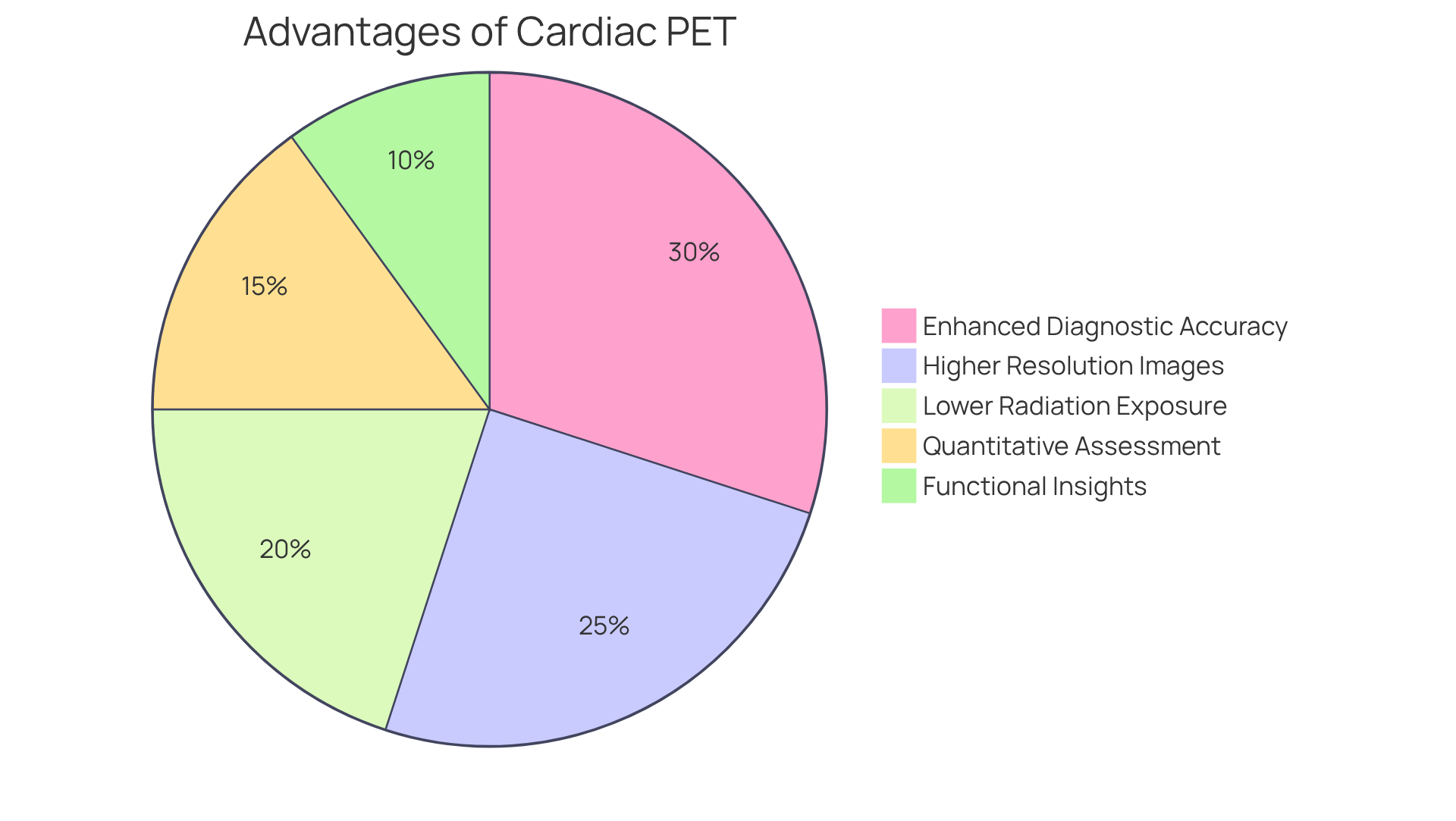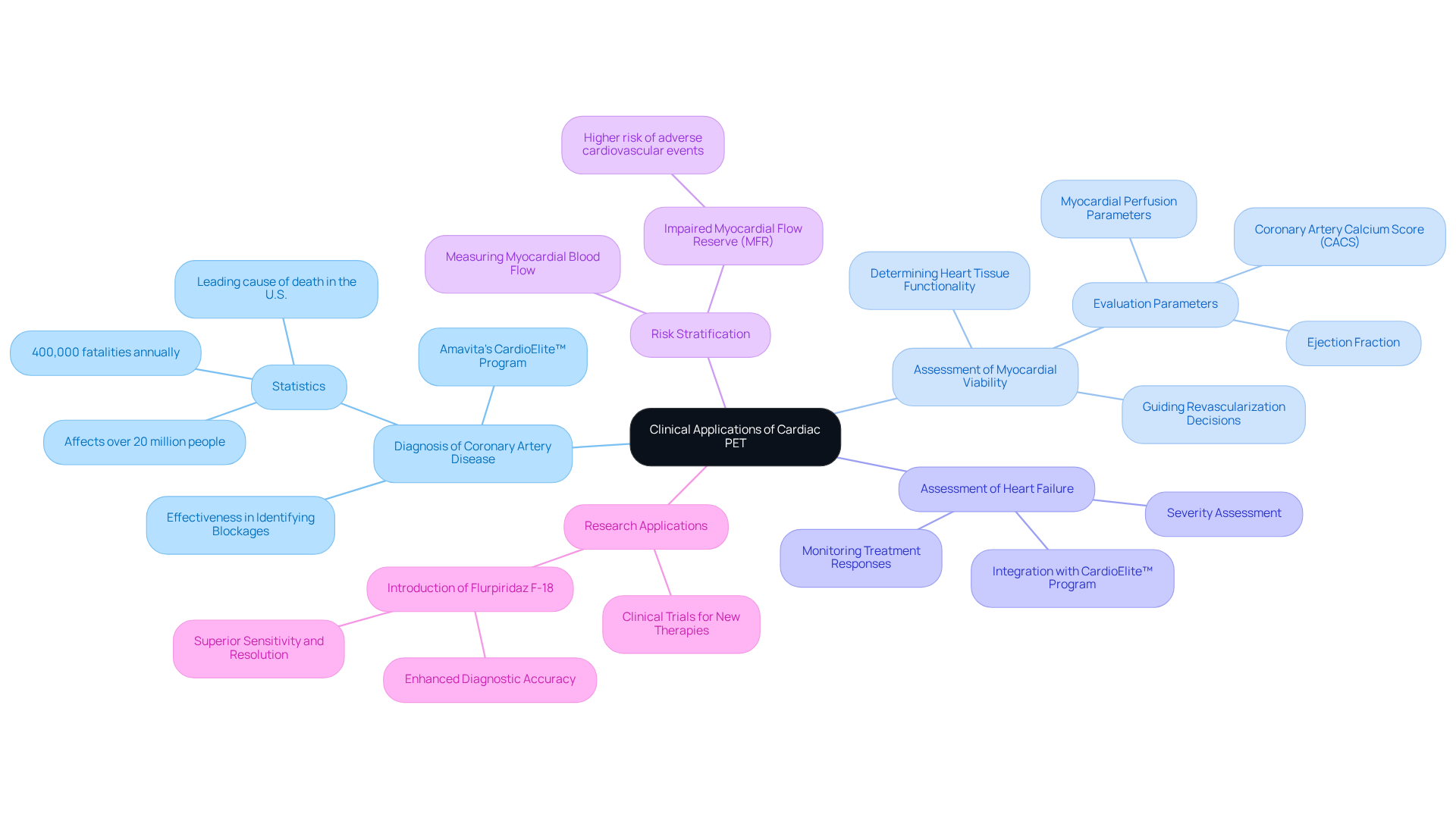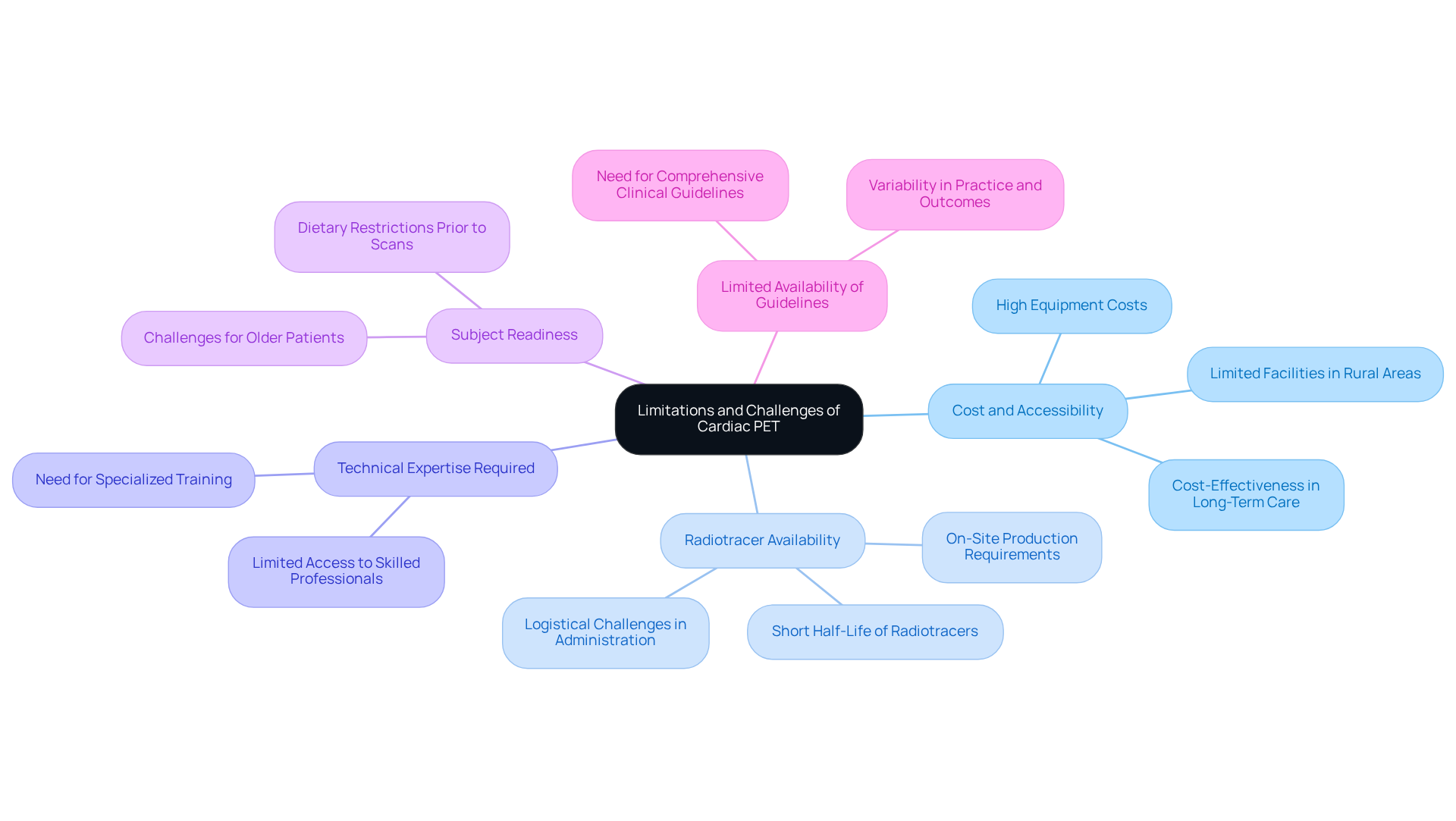


Cardiac PET, or Positron Emission Tomography, is a non-invasive imaging technique that plays a crucial role in diagnosing and managing cardiovascular conditions. It offers detailed insights into blood flow and metabolic activity in the heart, which can be especially important for those concerned about their heart health.
Have you ever felt anxious about understanding your heart's condition? You're not alone. Many patients share similar feelings, especially older adults with complex health needs. This is where cardiac PET shines. It provides superior image quality and lower radiation exposure, ensuring that you receive the best care possible without unnecessary risks.
Furthermore, cardiac PET allows for comprehensive functional assessments, giving you and your healthcare team a clearer picture of your heart's health. This can lead to more informed decisions about your treatment options.
We understand that navigating health concerns can be overwhelming. That's why it's essential to have access to advanced technologies like cardiac PET. They not only enhance diagnosis but also offer peace of mind, knowing that your health is being monitored closely.
If you have questions or need support regarding your heart health, please reach out. We're here to help you every step of the way.
Cardiac health is a vital concern for many, especially as countless individuals face challenges like coronary artery disease and heart failure. It’s understandable to feel anxious about these conditions. Among the advanced diagnostic tools available, cardiac PET (Positron Emission Tomography) shines brightly. It offers detailed insights into heart function and blood flow, making it an invaluable ally in the fight against cardiovascular disease.
However, despite its many advantages, you might wonder about its accessibility, cost, and the expertise needed to use this technology effectively. These are valid concerns, and it’s important to address them. How can patients and healthcare providers work together to overcome these challenges? By understanding the potential of cardiac PET, we can take steps toward improved heart health.
In addition to this, it’s crucial to remember that support is available. Whether you’re a patient or a caregiver, reaching out for help can make a significant difference. Together, we can navigate the complexities of cardiac care and ensure that everyone has access to the best possible resources for their heart health.
Cardiac PET, or Positron Emission Tomography, is a remarkable non-invasive imaging method that uses radioactive tracers to visualize blood flow and metabolic activity in the heart. This advanced technique, known as cardiac PET, plays a vital role in diagnosing various cardiovascular conditions, especially coronary artery disease (CAD) and heart failure. By creating detailed images of the heart's function and structure, cardiac PET enables clinicians to assess myocardial perfusion, identify areas of ischemia, and evaluate how well treatments are working. Its ability to detect abnormalities at a cellular level is particularly beneficial for managing cardiovascular health in older adults, who often face complex medical histories and multiple health issues.
Many older individuals are affected by CAD, and studies using cardiac PET indicate that over one-third of middle-aged adults in the U.S. are expected to develop this condition during their lifetime. Imaging methods such as cardiac PET are essential for early diagnosis and treatment, offering crucial insights into myocardial blood flow (MBF) and myocardial flow reserve (MFR). For example, studies have shown that cardiac PET can non-invasively diagnose cardiac allograft vasculopathy and predict all-cause mortality in heart transplant recipients, underscoring the diagnostic importance of cardiac PET.
Recent advancements in cardiac PET technology, including hybrid PET/CT scanning, have significantly improved its diagnostic accuracy and efficiency. This integration allows for three-dimensional imaging that reduces scanning time and minimizes radiation exposure, making it a safer option for patients. As the use of PET has tripled in the U.S. from 2010 to 2019, its role in cardiovascular health continues to grow, especially in identifying high-risk individuals who may benefit from revascularization strategies.
Overall, the use of cardiac PET is an invaluable tool in the comprehensive evaluation and management of cardiovascular conditions. If you or a loved one are concerned about heart health, consider discussing PET imaging with your healthcare provider. Remember, seeking help is a positive step towards better health and well-being.

Heart PET imaging brings numerous advantages over traditional methods like Single Photon Emission Computed Tomography (SPECT) and echocardiography, particularly for older adults who may have unique health concerns. Here are some key benefits that can make a real difference:
In summary, the advanced imaging capabilities of cardiac PET position it as a superior option for heart health assessment, especially for older individuals who require careful monitoring and precise diagnostics. If you have concerns about your heart health, consider discussing these options with your healthcare provider. You're not alone in this journey, and there are compassionate professionals ready to support you every step of the way.

Positron emission tomography (PET) for the heart is a valuable tool in various clinical situations, offering significant benefits for those dealing with heart conditions. Let's explore how it can help you or your loved ones.
Diagnosis of Coronary Artery Disease: Cardiac PET is particularly effective in identifying blockages in coronary arteries, especially for patients who may not exhibit typical symptoms. With coronary artery disease (CAD) being the leading cause of death for both men and women in the U.S., affecting over 20 million people and resulting in around 400,000 fatalities each year, this diagnostic method stands out. It provides exceptional sensitivity and resolution, making it a primary tool for CAD diagnosis. This is especially true within the context of Amavita's CardioElite™ program, which enhances proactive healthcare management through real-time diagnostic information and continuous cardiology consultation.
Assessment of Myocardial Viability: PET scans help determine if heart tissue is still alive and functioning after ischemic events. This information is crucial for guiding decisions about revascularization procedures. By evaluating myocardial perfusion parameters alongside the coronary artery calcium score (CACS) and ejection fraction, healthcare providers can tailor interventions to improve outcomes, particularly for those at higher risk due to diabetes, hypertension, or a family history of heart disease.
Assessment of Heart Failure: PET scans can also assess the severity of heart failure and monitor treatment responses, especially in individuals with complex health issues. This deeper understanding is vital for optimizing treatment strategies, aligning perfectly with the comprehensive approach of the CardioElite™ program, which integrates AI and AHA certification for enhanced care.
Risk Stratification: By measuring myocardial blood flow, cardiac PET helps to categorize individuals' risk for major adverse heart events (MACE). Recent studies show that those with impaired PET-derived myocardial flow reserve (MFR) face a significantly higher risk of adverse cardiovascular events. This reinforces the importance of this imaging technique in clinical decision-making and its integration into Amavita's advanced cardiovascular care.
Research Applications: Heart PET is also utilized in clinical trials to evaluate new therapies and interventions, contributing to advancements in cardiovascular medicine. The introduction of flurpiridaz F-18, a newly approved PET radiotracer, enhances diagnostic accuracy, offering superior sensitivity and higher image resolution for diagnosing CAD.
Insights from specialists like Ahmed Ibrahim Ahmed highlight the importance of PET MFR in CAD diagnosis and management, further emphasizing PET's role in improving care for individuals. As the landscape of cardiovascular care evolves, the use of cardiac PET remains a cornerstone in effectively diagnosing and managing heart conditions, particularly through the comprehensive strategies offered by Amavita's CardioElite™ program. Remember, you’re not alone in this journey; support is always available to help you navigate your heart health.

Cardiac PET imaging offers many benefits, but it also comes with limitations and challenges that we must address together:
Cost and Accessibility: The high cost of PET imaging equipment, often exceeding several million dollars, along with the need for specialized facilities, can limit access for many patients, particularly in underserved areas. Did you know that about 60% of PET diagnostic facilities are located in urban centers? This leaves rural and low-income communities with fewer options for this advanced diagnostic tool. However, it’s important to remember that PET is cost-effective due to its accuracy in diagnosing and treating cardiovascular diseases early, which can ultimately lower long-term healthcare costs. At Amavita Heart and Vascular Health®, we are committed to improving access to advanced diagnostic technologies and providing same-day convenience for high-risk individuals. We want to ensure that everyone, especially those in underserved communities, can benefit from our thorough evaluations and innovative cardiac therapies.
Radiotracer Availability: The short half-life of PET radiotracers, like Rubidium-82, which lasts only 76 seconds, can complicate logistics for timely administration. This may lead to delays in imaging, particularly in facilities that lack on-site production capabilities, affecting care for individuals. We understand how frustrating this can be, and we strive to minimize such delays.
Technical Expertise Required: Successfully executing and interpreting heart PET scans requires specialized training and expertise. Unfortunately, not all healthcare settings have access to professionals with the necessary skills, which can hinder the effective use of this technology. We recognize this gap and are dedicated to fostering expertise in our team to provide the best care possible.
Subject Readiness: Achieving precise outcomes from Heart PET scans relies heavily on suitable subject readiness. This can be particularly challenging for older individuals who may have various health concerns. Ensuring adherence to dietary restrictions and activity limitations before the scan is crucial, but we know it can be difficult to manage. Following specific guidelines, such as a high-fat, low-carbohydrate diet for 24-48 hours prior to the scan, is essential for enhancing test sensitivity. We’re here to support you through this process, making it as smooth as possible.
Limited Availability of Guidelines: While the use of PET for heart conditions is increasing, there’s still a significant need for comprehensive clinical guidelines to standardize its application across diverse patient populations. This lack of uniformity can lead to variability in practice and outcomes, complicating the integration of PET into routine clinical care. We are actively working to address this issue, ensuring that our practices align with the best available guidelines.
At Amavita, we understand these challenges and are dedicated to enhancing the accessibility and effectiveness of cardiac PET imaging. Our goal is to ensure that those in underserved communities can benefit the most from our advanced diagnostic capabilities, particularly through cardiac PET. If you have any questions or concerns, please don’t hesitate to reach out. We’re here to help you every step of the way.

Cardiac PET imaging truly shines as a vital tool in the world of cardiovascular health, offering invaluable insights into how our hearts function and their overall structure. Its non-invasive nature, combined with cutting-edge technology, allows healthcare professionals to diagnose and manage conditions like coronary artery disease and heart failure with impressive accuracy. As we learn more about what cardiac PET can do, it becomes increasingly clear that this imaging method is essential for taking proactive steps toward heart health management.
This article highlights several key advantages of cardiac PET. It boasts superior image resolution, lower radiation exposure, and enhanced diagnostic accuracy compared to traditional imaging techniques. By providing a thorough assessment of myocardial perfusion and metabolic activity, cardiac PET empowers clinicians to make informed decisions tailored to each patient’s unique needs. Furthermore, its applications in various clinical scenarios—ranging from risk stratification to evaluating treatment responses—underscore its crucial role in modern cardiovascular care.
Reflecting on the importance of cardiac PET, it’s essential to recognize both its benefits and the challenges that still exist. While cost and accessibility can pose barriers to widespread adoption, ongoing efforts are focused on improving availability and standardizing its use across different patient populations. Embracing this advanced imaging technique can lead to better outcomes for those at risk of heart disease. Have you had a chance to discuss the potential of cardiac PET with your healthcare provider? Engaging in these conversations is a proactive step toward ensuring your heart health and overall well-being.
What is Cardiac PET?
Cardiac PET, or Positron Emission Tomography, is a non-invasive imaging method that uses radioactive tracers to visualize blood flow and metabolic activity in the heart.
What role does Cardiac PET play in cardiovascular health?
Cardiac PET is vital for diagnosing cardiovascular conditions, particularly coronary artery disease (CAD) and heart failure. It helps assess myocardial perfusion, identify areas of ischemia, and evaluate treatment effectiveness.
How does Cardiac PET benefit older adults?
Cardiac PET is particularly beneficial for managing cardiovascular health in older adults, who often have complex medical histories and multiple health issues, as it can detect abnormalities at a cellular level.
What is the prevalence of coronary artery disease (CAD) among older individuals?
Studies indicate that over one-third of middle-aged adults in the U.S. are expected to develop CAD during their lifetime.
What insights can Cardiac PET provide regarding myocardial blood flow?
Cardiac PET offers crucial insights into myocardial blood flow (MBF) and myocardial flow reserve (MFR), which are essential for early diagnosis and treatment of cardiovascular conditions.
How has Cardiac PET been used in heart transplant recipients?
Cardiac PET can non-invasively diagnose cardiac allograft vasculopathy and predict all-cause mortality in heart transplant recipients, highlighting its diagnostic importance.
What advancements have been made in Cardiac PET technology?
Recent advancements include hybrid PET/CT scanning, which improves diagnostic accuracy and efficiency by allowing three-dimensional imaging, reducing scanning time, and minimizing radiation exposure.
How has the use of Cardiac PET changed over time?
The use of PET has tripled in the U.S. from 2010 to 2019, reflecting its growing role in cardiovascular health, especially in identifying high-risk individuals who may benefit from revascularization strategies.
Why should someone consider discussing Cardiac PET imaging with their healthcare provider?
Discussing PET imaging can be a positive step towards better heart health and well-being, especially for those concerned about cardiovascular conditions.